Landscape Evolution, Bedrock Rivers and Tectonic Geomorphology, Important Equations Review
1/30
Earn XP
Description and Tags
- Identify knickpoints and assess their origin from various datasets and transformations (longitudinal profiles, slope/area space, geologic map and history) - Understand the drivers of landscape evolution on passive margin landscapes like the Appalachian Mountains - Evaluate the theories for the formation of wind and water gaps given what we know about fluvial geomorphology. - Define the essential components of a laboratory or numerical landscape, including initial and boundary conditions, focusing on the physical features and processes that need to be represented - Explain how topographic change can be mathematically/numerically represented through processes such as advection, diffusion, and uplift, focusing on the basic principles behind each process. - Debate the benefits and drawbacks of numerical and physical experiments in understanding landscape evolution
Name | Mastery | Learn | Test | Matching | Spaced |
|---|
No study sessions yet.
31 Terms
Water Gap
Gap through a ridge with stream cutting the topography of the ridge
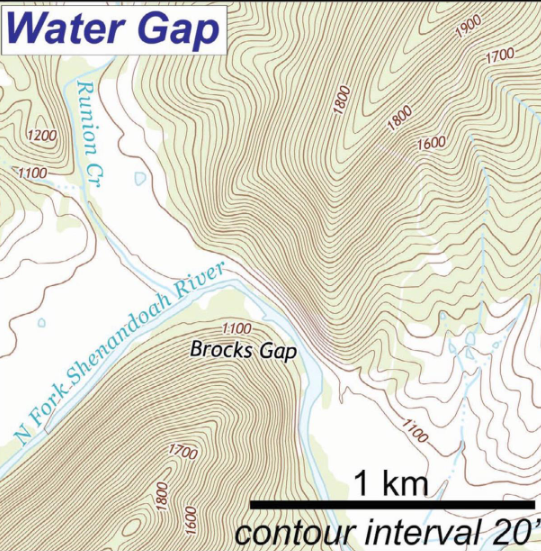
Wind Gap & Theories
Gap through a ridge but with no stream cutting through it
One theory suggests it used to be a water gap with the stream diverted by stream capture and headward erosion, but this is supposedly bogus
Rockfish water gap (now wind gap) should’ve shown watershed crossing from Shenandoah to Blue Ridge, but no fluvial deposition to prove this
Additionally, elevation differences across wind gap don’t seem feasible to have a stream at.
No real good other explanation, however
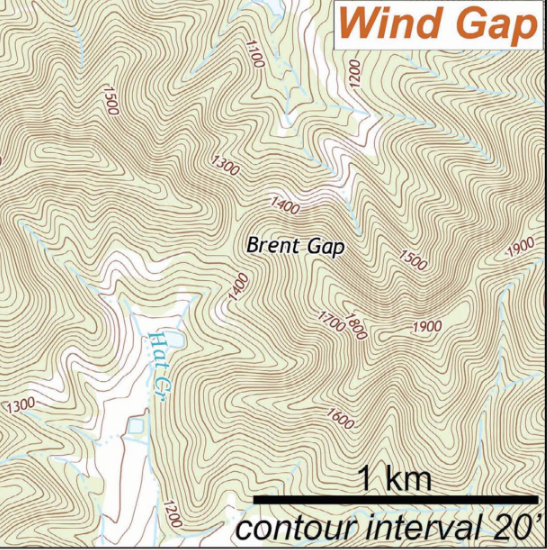
Stream Capture Cont.
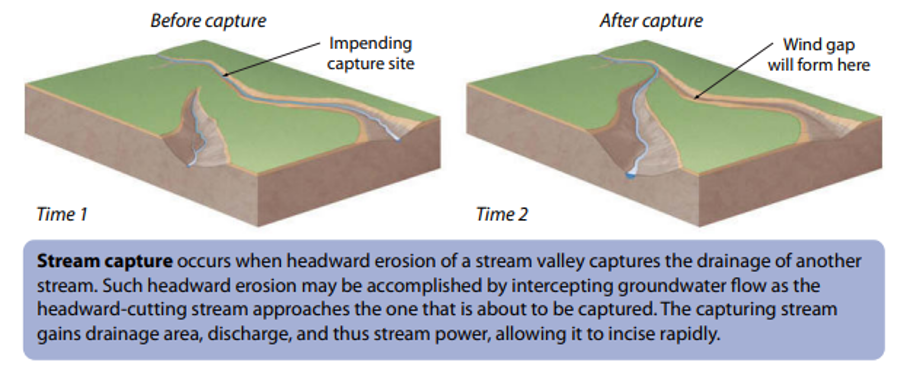
Hypsometry
The relative proportion of elevation to contributing drainage area in a drainage basin
Young —> Larger hypsometric integral and more contributing area at higher elevations
Old —> Smaller hypsometric integral and less contributing area at higher elevations
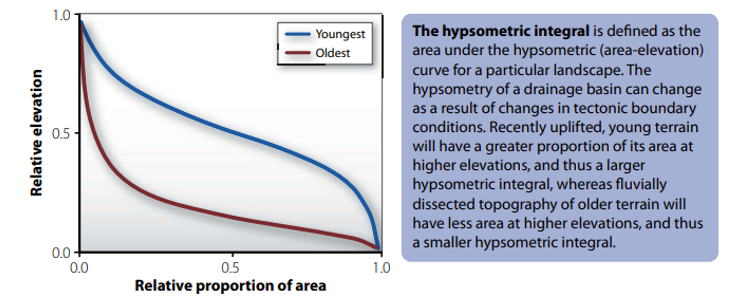
Main knickpoint-forming causes
Rising base level
Tectonic uplift
Also tectonic processes such as faulting
Different lithology
Hack’s Law
As the distance along a stream increases, so does the drainage area and therefore discharge
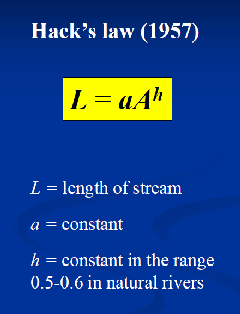
Fluvial Power Law
Generally, as slope increases, the drainage area of a stream decreases and vice versa.
Slope of a channel varies as an inverse power law of drainage basin area modified by steepness index (uplift and precipitation effects) and concavity (process domain characteristics)
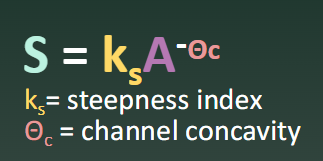
Stream Power
Stream Power = (gravity)(water density)(discharge)(slope)
Unit stream power can be found by dividing this by width of stream

Stream Power Reformulated (Erosive Power)
Discharge changes in accordance with drainage area, so drainage area is substituted for discharge in the stream power equation.
K = Constant based on rock type, precipitation, et.
A = Drainage Area
S = Slope
m = Relative importance of drainage area
n = Relative importance of slope

Elevation Change Equation (NEW; DIRECTLY LINKED TO LEARNING OBJECTIVE)
Elevation Change = Soil Diffusion - Stream erosion + Uplift

Diffusivity Equation (when soil production balances erosion)
Erosion rate = (Diffusivity)(Curvature)
Used to model hillslopes with majority diffusive processes
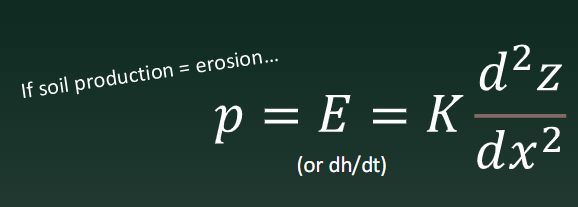
Why are hillslopes convex?
Assuming constant soil height, q = KS, where soil flux increases proportionally with slope, and the idea of soil boxes with accumulating flux
As your distance from the ridge increases and therefore your accumulated flux, the slope of the hillslope must increase, steepening it in such a way that the hillslope must be convex shaped
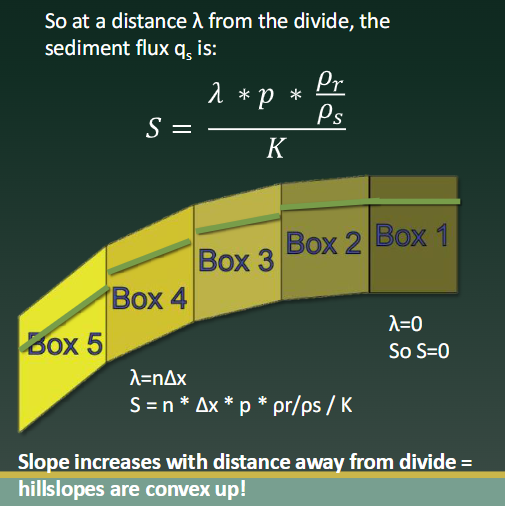
Why are channels concave?
According to Hack’s Law, as distance along a stream increases, so does drainage area/discharge, while fluvial power law states slope decreases as drainage area increases.
Thus, as length across a stream increases, slope decreases, creating a concave profile
Hydraulic Radius
Area of flow / Wetted perimeter
Effects of Hydraulic Radius on Various Components
Higher hydraulic radius = Higher shear stress on bed
Streambed stress equation
Higher hydraulic radius = Faster flow velocity
Manning’s Equation
Manning’s Equation
Flow velocity = (Hydraulic radius)^0.66(Water-surface slope)^0.5 / Manning’s Roughness Coefficient
Hydraulic Radius is more important than slope
For hydraulic radius, a larger wetted perimeter with the same area = lower velocity of water

Manning’s Roughness Coefficient
Determines roughness of stream; empirical constant you plug into Manning’s Equation
I suppose this represents the resistance the streambed acts on the water passing over it
Darcy’s Law
Q = KA(Δh/L)
Discharge = (Hydraulic Conductivity)(Cross-Sectional Area)(Slope)
For subsurface flow
Hillslope Hydrology Review:
Horton Overland Flow
Saturated Overland Flow
Shallow Subsurface Storm Flow
Shallow Subsurface Storm Flow:
Infiltration capacity > Rainfall rate
Subsurface flow that does not breach the surface
Horton Overland Flow:
Infiltration capacity < Rainfall rate
Subsurface is not saturated; water all flows above land due to lack of permeability
Why deserts flood so fast and dramatically; desert pavement
Saturated Overland Flow:
Infiltration capacity > Rainfall rate
Subsurface is saturated; overland flow as soil is full
In concurrence with shallow subsurface storm flow
Max Amount of Water before Overland Flow (wmax)
ksin(θ)cos(θ) = Linear shallow subsurface flow discharge
k is hydraulic conductivity from Darcy’s Law
kcos(θ) represents what leaves on overland flow (?)
sin(θ) represents what is going down through the soil (?)
bdsoil = Dimensions of the soil; makes SSF 3D
A = Drainage area
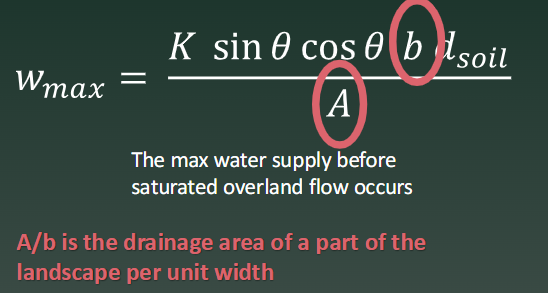
Shields Equation
Difference in grain density and water density
Slope
Shield’s Parameter
D50 of the Sediment (median grain size)
AN INCREASE OF ANY OF THESE INCREASES SHEAR STRESS NEEDED TO MOVE PARTICLES ON STREAMBED (or… at least the median sized particle)
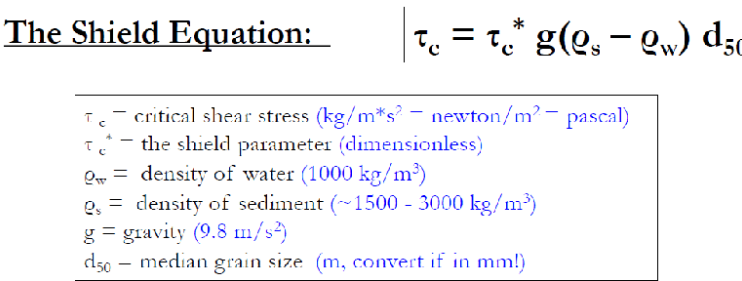
Initial Conditions
The setup of a model before the experiment begins
Ex. Starting elevation/volume
Ex. Shape of sand in a hillslope tub (Lab 6 example)
Boundary Conditions
The rules that govern what happens at the edges of a model
Ex. The edges of a box or the edges of a graph model, holding sediment in
Minimum and maximum heights on edges. etc.
Time Step
For most model, a time step is essential to processing change over time in a model
Ex. New data every 5 minutes, etc.
Landscape Evolution Factors
Landscape evolution:
o Tectonics
o Climate
o Topography
o Geology
o Biology
o Similar to ClORPT
Three Types of Models
Conceptual models
Physical models
Like our hillslope box
Mathematical models (which can be translated to computer models)
Conceptual — Dynamic equilibrium
Landscape characteristics vary over time around a central tendency
Ex. Erosion and uplift rates are about equal; mature landscape

Mathematical — Transport Laws
Generalized mathematical expressions formalizing relationships between sediment movement and key governing variables
Mathematical transport law for diffusive processes
Sediment discharge = (Rate Constant)(Slope)
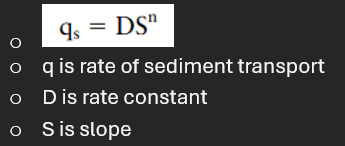
Mathematical transport law for advective processes
THE SAME ONE AS EROSIVE POWER THAT WE FORMULATED IN LECTURE

Effect of Toggling Diffusion in a Digital Landscape Model
On — Less streams as they seem to fill in and diffusive processes act
Off — Much more channel dominated with few smooth hillslope formations indicative of diffusion processes